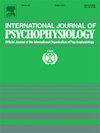在侧卫任务的大部分兼容块中,主动控制对中心区域的异常加工没有影响
IF 2.5
3区 心理学
Q3 NEUROSCIENCES
引用次数: 0
摘要
在侧翼任务的比例相容性效应背后,我们假设在最不相容(MI)任务中,主动控制比在最相容(MC)任务中更能增强中央区域的加工。本研究旨在检验这一假设,并将重点放在中央区的异常加工上。共有45名成年人完成了侧卫任务,其中包括中心偏差刺激。在MC和MI块中,比例偏差被罕见(15%)和等概率(50%)条件所操纵。中心偏差刺激和典型刺激的中心箭头和周围箭头的颜色不同。因此,在罕见和等概率条件下,通过比较中心偏差刺激的事件相关电位来评估中央区域的偏差处理。中心偏差刺激的N1差异和视觉错配负性在MI和MC块之间无显著差异。这些结果表明,主动控制对中间区域的异常加工没有影响,这与假设相矛盾。此外,与MC组相比,MI组中中心偏差刺激和典型刺激的N1均显著降低,这表明MI组的加工总量比MC组减少。这些发现表明,MI的主动控制阻断了周围区域的加工功能;然而,它并没有增强中心地区的加工能力。本文章由计算机程序翻译,如有差异,请以英文原文为准。
No effects of proactive control on deviant processing in the central area in mostly compatible blocks of the flanker task
Behind the proportion compatibility effects in the flanker task, processing in the central area was hypothesized to be enhanced by proactive control in the mostly incompatible (MI) blocks compared with the mostly compatible (MC) blocks. This study aimed to examine this hypothesis and focused on deviant processing in the central area. A total of 45 adults performed the flanker task, which included central-deviant stimuli. Proportion deviance was manipulated by rare (15 %) and equiprobable (50 %) conditions in the MC and MI blocks. The color of the central and surrounding arrows was different and the same between the central-deviant and typical stimuli, respectively. Thus, deviant processing in the central area was evaluated based on a comparison of event-related potentials for the central-deviant stimuli between the rare and equiprobable conditions. The N1 difference and visual mismatch negativity for the central-deviant stimuli did not significantly differ between the MI and MC blocks. These results suggested that proactive control in the MI blocks had no effects on deviant processing in the central area, which contradicted the hypothesis. In addition, N1 for both the central-deviant and typical stimuli was significantly reduced in the MI blocks compared with the MC blocks, suggesting that the total amount of processing was reduced in the MI blocks compared with the MC blocks. These findings suggest that proactive control in the MI blocks functions to inhibit processing in the surrounding area; however, it does not enhance processing in the central area.
求助全文
通过发布文献求助,成功后即可免费获取论文全文。
去求助
来源期刊
CiteScore
5.40
自引率
10.00%
发文量
177
审稿时长
3-8 weeks
期刊介绍:
The International Journal of Psychophysiology is the official journal of the International Organization of Psychophysiology, and provides a respected forum for the publication of high quality original contributions on all aspects of psychophysiology. The journal is interdisciplinary and aims to integrate the neurosciences and behavioral sciences. Empirical, theoretical, and review articles are encouraged in the following areas:
• Cerebral psychophysiology: including functional brain mapping and neuroimaging with Event-Related Potentials (ERPs), Positron Emission Tomography (PET), Functional Magnetic Resonance Imaging (fMRI) and Electroencephalographic studies.
• Autonomic functions: including bilateral electrodermal activity, pupillometry and blood volume changes.
• Cardiovascular Psychophysiology:including studies of blood pressure, cardiac functioning and respiration.
• Somatic psychophysiology: including muscle activity, eye movements and eye blinks.

 求助内容:
求助内容: 应助结果提醒方式:
应助结果提醒方式:


